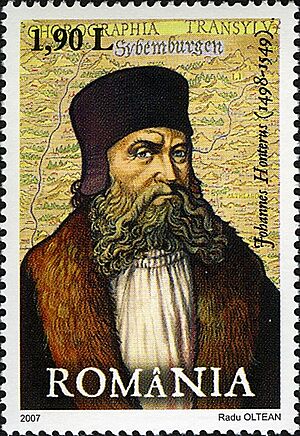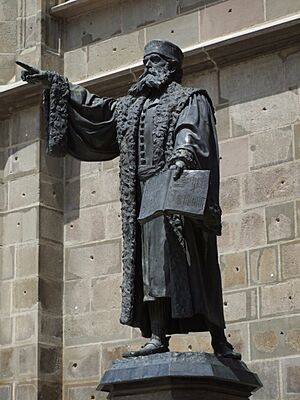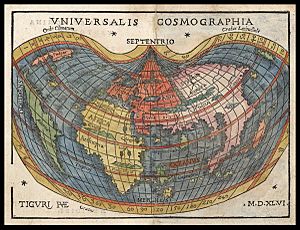Johannes Honter facts for kids
Quick facts for kids
Johannes Honter
|
|
|---|---|

Honterus on a 2007 Romanian stamp
|
|
| Born |
Johannes Honter
1498 |
| Died | 23 January 1549 (aged 50–51) Brassó, Transylvania
|
| Education | University of Vienna (1520–1525) University of Kraków (1530) |
| Era | Reformation |
| Known for | founding the Evangelical Church of the Augsburg Confession in Transylvania |
Johannes Honter (born in 1498 – died January 23, 1549) was a very important person from Transylvania. He was a humanist (someone who loved learning), a Protestant reformer (he helped change the church), and a theologian (a religious scholar).
Honter is best known for making maps and publishing books about geography. He also helped bring the Lutheran faith to Transylvania. He founded a church that later became the Evangelical Church of the Augsburg Confession in Romania.
Contents
Honter's Early Life and Studies
Growing Up in Transylvania
Johannes Honter was born in a town called Brassó in Transylvania. Today, this town is known as Brașov in Romania. Back then, it was part of the Kingdom of Hungary.
Learning in Vienna and Kraków
From 1520 to 1525, Honter studied at the University of Vienna. He earned a special degree called magister artium, which is like a master's degree today.
In 1529, a powerful army from the Ottoman Empire tried to attack Vienna. Because of this, Honter moved away. He first went to a city called Regensburg. Then, in 1530, he went to Kraków in Poland. He studied at the Jagiellonian University there. In Kraków, he published his very first books. One was a Latin grammar book, and the other was a guide to cosmography (the study of the universe).
Becoming a Skilled Engraver
Between 1530 and 1532, Honter lived in a city called Basel. While there, he learned and practiced wood engraving. This is a way of carving designs into wood to print pictures. He became very good at it. He even designed two maps of stars that showed his amazing skills.
During this time, he often traveled back to Transylvania. He gathered information to create a map of his home region. This map was called Siebenbuergen. He carved and printed it in Basel. It was the very first map of Transylvania ever printed! Only one copy of this map is known to exist today. Honter wasn't completely happy with his map. He tried to get back all the copies he had sent out so he could make it even better. His map became the basic design for all future maps of Transylvania for many years.
Honter's Return and Impact
Bringing New Ideas to Brașov
In 1533, Johannes Honter returned to his hometown of Brassó. While he was traveling in Europe, he had learned about new ideas from the Protestant Reformation. He worked hard to introduce these Lutheran ideas to Transylvania. He wanted to share knowledge with as many people as possible.
To do this, he did several important things:
- He founded a humanist school, which is still open today as the "Johannes Honterus" School.
- He set up a printing press in 1539. This allowed him to print many books.
- He wrote and printed many books himself, including one about church reforms.
- He helped start a paper mill, which made it easier to get paper for printing.
The Famous Rudimenta Cosmographica
In 1542, Honter printed a new version of his cosmography book in Brassó. This time, he wrote it in verse (like a poem). He called it Rudimenta Cosmographica. He thought that writing it in verse would help students remember the information better.
This book also included 13 maps that Honter had engraved himself. These maps showed all the parts of the world that were known at the time. The Rudimenta was incredibly popular! It was printed 39 times in many different cities across Europe, like Zürich, Antwerp, and Prague. The book was last reprinted in 1602, and parts of it were used in other books until 1692. It was truly one of the first widely used textbooks in Europe.



